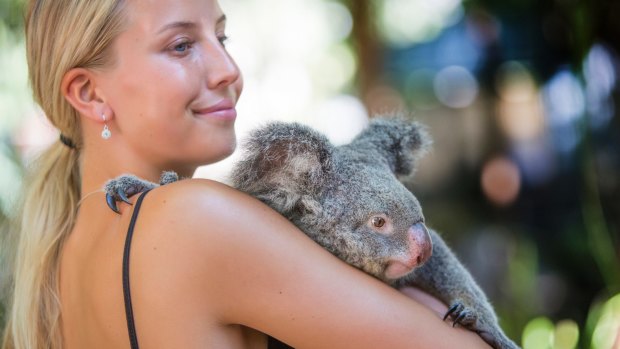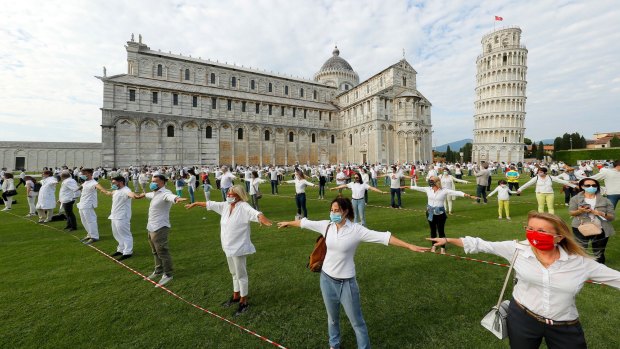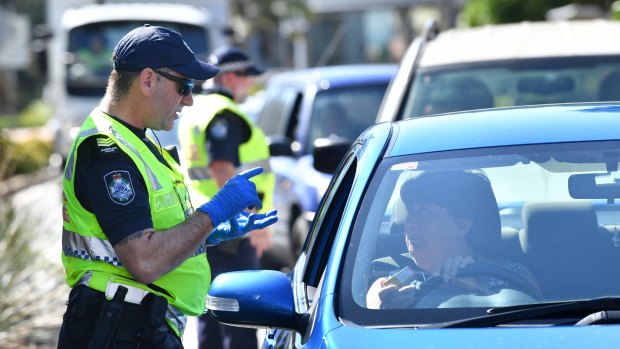This was published 3 years ago
Tourism, coronavirus and travel bubbles: Why our COVID-19 success is good and bad for Australia's tourism industry
By Anthony Dennis

A tourist holds a koala on Magnetic Island, Queensland.Credit: Getty Images
Waiting for a bubble to inflate can be a deflating experience, just ask any tourism operator from Australia, New Zealand and the Pacific. They are beginning to believe the so-called trans-Tasman travel bubble is full of hot air as politicians dither over a launch date.
Australia and New Zealand's success in containing COVID-19 paradoxically now represents a blessing and a curse for the tourism industry.
Italy, which has recorded around 34,000 deaths and more than 235,000 cases of COVID-19, with 32,872 still active, has already re-opened to tourism, with foreign visitors delivering close to 15 per cent of its GDP. Contrast that with Australia and New Zealand, two countries whose borders remain closed despite having an enviable combined case load of well under 10,000 and 124 deaths. Some see the lack of action over border openings as a mishmash of cross-border intransigence, indecision and caution.
By Australasia's lofty standards, Italy should still be in lockdown. But economic reality combined with the monetary lure of the traditional northern hemisphere summer tourism season, has led it to confront the stark choice between public health and financial ruin.

Credit: EPA
Meanwhile most Australian states and New Zealand await some sort of miracle, unsustainable COVID-19 perfection in a vaccine-free world before inflating the travel bubble, even though our paralysed travel industry cannot afford to hold off any longer. It's a reality that was recognised by the NSW and Victorian Premiers when they recently fully relaxed travel restrictions. .
And Queensland Premier Annastacia Palaszczuk is now under growing pressure by her state's tourism industry to revive a July restart of interstate travel, instead of a recently floated date of September, which would see operators miss out on the lucrative winter holiday season beloved by chilly southerners.
Across the ditch, Winston Peters, New Zealand's deputy prime minster, has expressed frustration about Australia's internal border closures, saying a trans-Tasman bubble could have started this week if not for the stances of our state premiers and chief ministers.

Credit: Darren England
The longer the delay in opening all internal borders and access to New Zealand and the Pacific, the greater the risk of businesses not only becoming insolvent, but much, or all, of the industry collapsing. This would conceivably leave Australia with far fewer viable hotels, resorts and attractions, rendering it a much less competitive destination for international tourism when it finally returns.
Part of the local frustration is the knowledge that unless all state borders are open, tourism operators will be unable to fully target the millions of Australians unable to travel overseas this year.
Now unable to rely on the intransigence of politicians, some of whom have elections in the offing, Australia's tourism industry is seeking an extension of the federal government's JobKeeper program to at least 2021 when it hopes international borders beyond New Zealand and the Pacific will reopen.
Based on the existing strict COVID-19 standards of Australian states, such as Queensland, South Australia and Western Australia, as well as New Zealand, it's difficult to see how any further international borders could be fully reopened in the medium term.
Even Singapore, one of the more successful COVID-19 nations and a near neighbour, is unlikely to qualify for any bubble and forget the laggard US and UK until further notice.
To add to the misery of the tourism industry, which employs between 600,000 and almost a million Australians, depending on which statistical estimates are to be believed, a dark cloud also hovers over the future viability of the China inbound tourism market, worth $12 billion per annum to the Australian economy.
New Zealandis in an even more invidious position with tourism accounting for a dangerously high 20 per cent of exports (compared with more than five per cent for Australia) while tourism comprises a whopping 40 per cent of the Fijian economy.
To be sure, politicians on both sides of the Tasman face an excruciating choice between protecting the exceptional gains made in controlling COVID-19 and the urgently-needed full reintroduction of tourism and border openings.
Inflating the bubble will likely come at some cost to public health but the price of maintaining a sort of clinical isolationism may prove even more costly to not only Australia, but also our near, and even more tourism dependent, neighbours.
See also: Good riddance: Seven things in travel that won't be coming back
See also: Why Qantas passengers shouldn't be fooled by Joyce's $19 airfares
Anthony Dennis is travel editor of The Sydney Morning Herald and The Age
Sign up for the Traveller newsletter
The latest travel news, tips and inspiration delivered to your inbox. Sign up now.